12 Innovations That Changed Our World
The United States is an innovative nation fascinated by new ideas and impatient for improvement. Innovation is a line that weaves throughout our history—an electrified kite string that becomes a high-voltage power line, a telegraph wire, an optical phone cable, and an antenna that eventually dissolves into a cloud of wireless information. Innovation is a view of our country from a speeding car, a 75th floor office suite, a commercial flight at 30,000 feet, or a lunar craft 230,000 miles from home.
More than any single individual, invention, technology, or improvement, true innovation is an ever-evolving process—the product of unfenced thinking and hard work.
The Post salutes the past, present, and future innovations that shape the way we live, work, and play.
1. Capturing Lightning
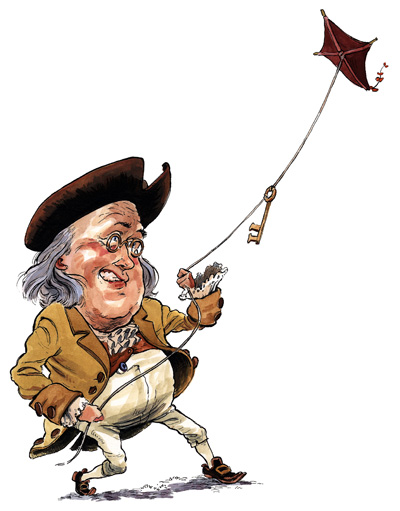
Benjamin Franklin was the first major innovator in America. Through his experiments and writings, he educated the world on the nature of electricity, how it was conducted, and how it might be stored. He also helped reconcile religious leaders to scientific truths. As Post writer and historian Samuel Eliot Morison observes, before Franklin, “it was generally supposed to be immoral to assert a scientific cause for phenomena such as earthquakes, shooting stars, and thunder and lightning. Thus, Franklin’s proof of electricity’s causing lightning … took out of the field of religion something earlier classified as a mere act of God and included it in natural science.” Franklin’s work as a diplomat for science inspired other Americans to wrestle new destinies from the elemental forces.
A pioneer in many fields, Nikola Tesla developed alternating-current technology — considered one of the greatest discoveries of all time by many — to supply power to factories. His breakthrough enabled electricity from a power plant to travel over long distances, reaching far into the country, instead of being restricted to the few blocks around a power plant. Later, in the 1960s, physicists Bardeen, Brattain, and Shockley developed a replacement for the electronic vacuum tube. Their transistor, a small and simple device, marked the beginning of solid-state electronics and much smaller appliances. Televisions were no longer the size of washing machines. Portable radios could be hidden in a pocket. And computers shrank from the size of buildings to something that could slip down between the couch cushions.
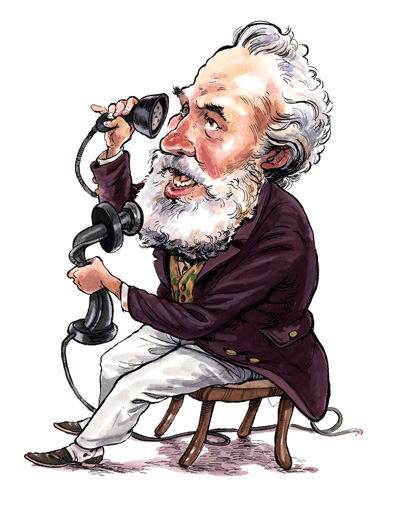
2. Global Conversation
Samuel Morse wasn’t the only inventor working with telegraphy. But he was the first to offer a reliable, working system. In 1844 he demonstrated its efficiency in Washington by conversing with his associate in Baltimore 30 miles away. By the 1870s, Washington was telegraphing news to San Francisco, 2,400 miles away — a distance that required 60 days by coach. Years passed before Americans fully realized his accomplishment of removing the physical limits of exchanging thoughts. Communication traveled faster than the swiftest carriage or train. People could move ideas as quickly as they could think them.
As telegraph lines rose across the country, Alexander Graham Bell was filing his patent for a device to transmit the human voice. Early users felt shy about shouting into a receiver and listening through the static for a shouted reply, knowing that anyone in the neighborhood could quietly lift a handset and listen in. By the 1980s, this shyness had disappeared when Americans adopted Martin Cooper’s cellular phone. Telephone receivers shrank in size from a brick to a large earring, and it soon became hard not to listen to other people’s phone calls.
3. Americans Hit the Road
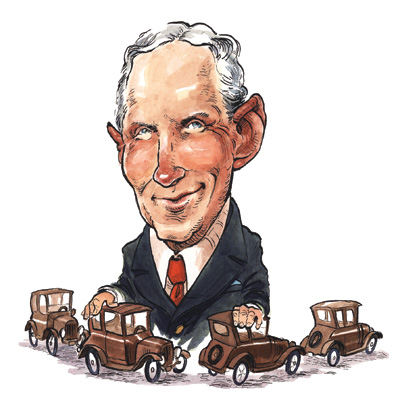
Henry Ford did not invent the automobile. His great innovation was introducing mass production to car manufacturing, launching an assembly line that enabled factory workers to build more than 18,000 cars in 1909. By 1920 Ford was selling about a million cars each year.
Americans adopted the automobile like a long-lost relative. People learned to drive, exploring the countryside and relocating when opportunity beckoned. They also began living farther from work, spawning the growth of suburbs.
America was expanding, both horizontally and vertically. Architect William Le Baron Jenney exchanged stone for metal frames and beams when he built Chicago’s Home Insurance Building in the 1880s. The 10-story structure weighed only as much as a three-story conventional building. Jenney’s success at 138 feet was doubled with the 285-foot Flatiron Building in 1902, and quintupled with the 1913 Woolworth Building. The horizon of cities rose and skyscrapers began dwarfing church steeples. In the wake of 9/11, few cities are planning to build skyscrapers that might draw the attention of terrorists. However, the Burj Dubai in the United Arab Emirates, upon completion, will reach 160 stories — half a mile high.
4. Illuminating the Country
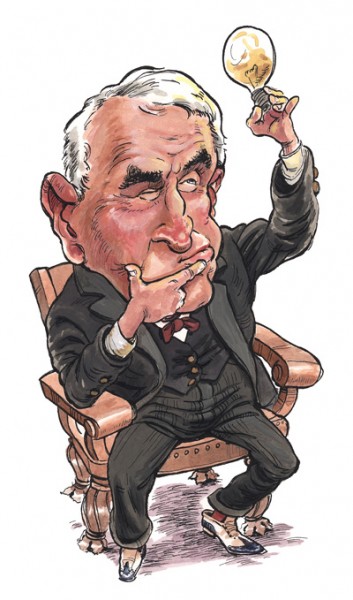
While city dwellers ventured into the countryside, farm families migrated toward the city. Even though Thomas Edison regretted the shift, his work rendered it inevitable. Like most of his creations, the incandescent light bulb was a coincidental discovery. He discovered a workable filament for his light bulb by randomly trying thousands of materials before finding the answer in carbonized bamboo fiber.
With electric light, night lost its power to regulate Americans’ lives. Business operated around the clock. As Samuel Insull began building power plants across the Midwest, the faint glow of cities — once visible only in the eastern night sky — began to appear in the West.
Today, as cities grow brighter and the electric glow washes out the sky for miles, innovators are developing new light sources that cut down ambient lighting, focusing illumination where needed and reducing wasted light and energy demands.
5. Advent of Sound
American ingenuity was pushing back the silence of the frontier as well as its darkness. Edison discovered how to mechanically capture sound waves on wax and produced his “Ediphone,” which he intended to sell as a business dictation machine. Coincidentally, he discovered that his machine could record music.
True to form, Edison developed his sound machine through trial and error, without any underlying theory. And, just as typical, Edison stuck with his original ideas, using cylinder recordings — though discs were more practical — and personally selecting the music his studio recorded, despite his limited tastes and deafness in one ear.
Edison’s stubbornness created an opportunity that Eldridge Johnson seized when he founded the Victor Talking Machine Company. He brought a less expensive phonograph to the market and began recording a broader variety of music. His recording company achieved unimaginable success when, as an experiment, it began selling records of blues, jazz, gospel, and country music. The entertainment industry discovered a devoted following for music, a need largely ignored by polite society.
In the 1950s, engineers introduced long-playing records that offered more music with greater fidelity. At the same time, David Paul Gregg was busy working on his optical disc that used a laser to read audio data. Twenty years later, his development became the compact disc: a small, durable medium of complete fidelity that resisted scratches and static. Fifteen years later, the MP3 protocol compressed music into small computer files that could be transferred, stored, and played on miniature players. Today, Americans play more music than ever on personal MP3 players, which can be seen everywhere from the suburbs to the front lines in war.
6. Populating the Airwaves
As Edison pressed voices into wax cylinders, American scientists attempted to direct voices through the air. They experienced little success until Nikola Tesla, in 1895, developed the technology to transmit a sound signal from New York to West Point, 50 miles away. By the 1920s, radio amateurs were transmitting signals across the country and wracking their brains for broadcasting material. They read agricultural lectures, delivered sermons, relayed news from local papers, or played records. Several states away, enthusiasts fiddled with cat’s whiskers and coils on homemade sets, eager for any sound. Farm boys strung up wire to hear the talk and static of distant Chicago or New York.
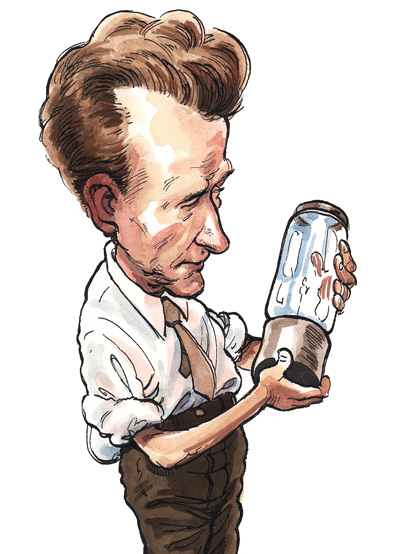
Philo T. Farnsworth, a mathematical genius from Utah, successfully added a visual element to radio signals when he introduced the image dissector tube. The device, which he first built while in high school, enabled him to capture and transmit moving images. He broadcast America’s first television signal in 1927. The Radio Corporation of America eventually bought his patent and made the first public television broadcast from the 1939 New York World’s Fair. The first regularly appearing television show hit airwaves in 1947. Television stations struggled by on little revenue, and early programming favored cheap entertainment.
While some were critical of the quality of programming, no one could deny that televisions had become more sophisticated. Today, companies sell 150-inch, high-definition TVs and are developing contact lenses that transmit television shows.
7. Moving Pictures
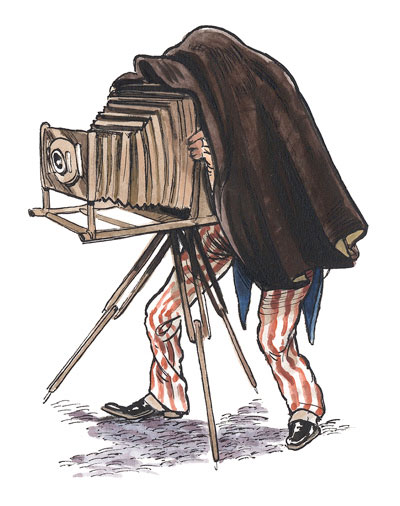
America quickly realized that television could not replace its favorite form of entertainment: the movies. America’s motion picture industry was among the largest and most profitable in the world. Its earliest incarnation was Edison’s Kinetoscope: a hand-cranked viewer that showed a few minutes of dancing, gymnastics, or people simply walking down the street. Yet this humble beginning sparked an immense appetite for film.
Edison began work on a projector that allowed crowds to watch the same images. But Edison’s greatest contribution to the new industry was a curious little production called The Great Train Robbery. The 10-minute drama—crude, choppy, and over-acted—inspired other innovators with the possibilities of cinema.
No less remarkable was the innovation of George Eastman. His Kodak camera company encouraged Americans to take up what had been the expensive hobby of photography. Customers bought his camera, containing enough film for 100 images. After the film was exposed, the photographer mailed the entire camera back to Eastman’s laboratories, which sent back the pictures and a reloaded camera. Personal photography ceased being a rarity.
Now, with digital cameras, photographers are pushing the limits of what can be captured. High-definition displays and computer enhancement give photographs a level of detail that extends the capabilities of the human eye.
8. America Takes Flight
The Wright brothers approached flight with the enthusiasm of hobbyists, but realized they would have to master the science of aerodynamics. They built from the ground up, testing everything, and often finding their textbooks wrong. The brothers worked relentlessly against limited information and slim funds, crouching in a shack on the North Carolina coast, as 70 mph-winds tore against their machine. Finally, in December 1903, they succeeded. A half century passed before air travel became affordable.
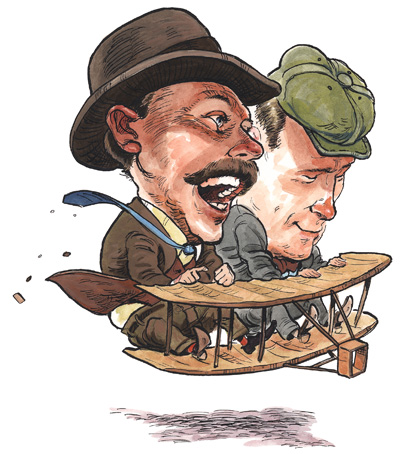
Fascinated by the Wright brothers’ achievement, Americans failed to notice the work of another innovator. Robert Goddard grew up with a dream of traveling beyond Earth’s atmosphere, where aircraft could not depend on air resistance. Realizing that travel in the vacuum of space would require an engine to bring along its own oxygen, Goddard developed a rocket design that could carry its own fuel and created the multistage rocket that would jettison its own starter motor as it struggled against Earth’s gravity. In the 1930s, his research team was launching supersonic rockets 1.5 miles from earth. Almost predictably, he was discounted as a crackpot for talking about space travel, and the armed forces saw no military application in his missiles. Goddard died in 1945, just as America realized the vast potential of his work. Twenty-four years later, Americans crossed space, landed on the moon, and returned.
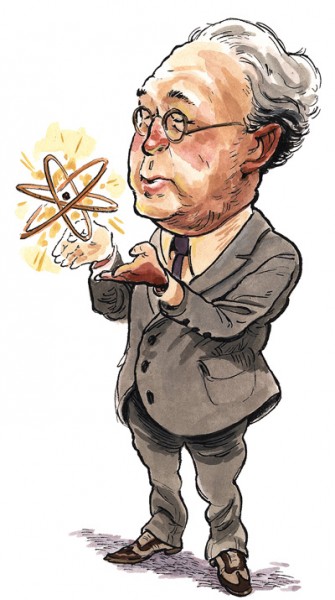
9. Tapping New Energy
Early in his career, Italian born Enrico Fermi realized it was possible to control the disintegration of uranium and start a chain reaction that would release massive energy. Working with physicist Leo Szilard, Fermi achieved nuclear fission for the first time in 1942. His research led to the development of an atomic bomb for the United States military. After dropping two atomic bombs on Japan, Americans became deeply concerned about this new, nuclear science. In 1946, a Post editorial warned: “If we are not destroyed by our own curiosity and rising standards of destructiveness, we could drift along, constantly testing the warlike possibilities in the atom until some other nation got the secret.” The remark was highly prophetic. Russia developed nuclear weapons in 1949. But Fermi hesitated to build a nuclear device with greater power, believing that such a device could only result in genocide.
America’s fears over nuclear disaster overshadowed promising applications such as nuclear medicine. Data from nuclear imaging has saved countless lives by detecting cancerous growths in their early stages. Another development, nuclear power generation, continues to face criticism. Despite Americans uneasiness about nuclear energy, nuclear reactors generate nearly 20% of our country’s electricity. Innovators are looking beyond the large nuclear plants to the potential of scaled-down reactors for neighborhoods or individual houses, which would be smaller than a garden shed.
10. Outsourcing Brainwork
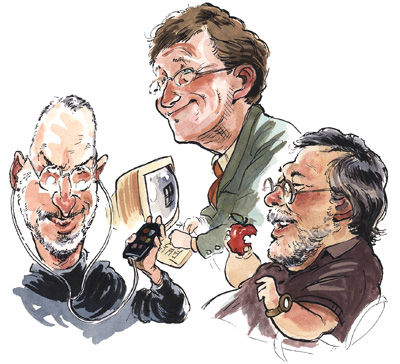
While America’s attention focused on atomic power, a quiet innovation was underway that would prove even more powerful. George Stibitz was building a digital computer on his kitchen table. By 1940 the device could perform sophisticated mathematical calculations. While Stibitz used his computer to model biochemical systems in the human body, other innovators were looking at computer programs for more general interest.
Eventually, the personal computer (PC) made its debut in the late 1970s. At first a PC seemed as practical as a personal aerospace program. Yet innovators such as Apple’s Steve Jobs and Steve Wozniak developed affordable computers for everyday business operations. In 1979 the duo created an operating system that didn’t use advanced logic and computer language. This development, along with practical programs for word processing and spreadsheets, encouraged America to incorporate digital technology in their lives.
Thousands of tinkerers and hackers played with digital systems, often with only a burning curiosity to see what they could do. A man named Bill Gates aided the effort. His genius for programming and business helped him build the Microsoft Corporation. Not only did Gates assist America’s programmers in developing software, he helped standardize the industry so different systems could converse in a common operating system.
11. Computer Age
When Lawrence Roberts developed a system for sending data packets between computers, he had little idea where the innovation would lead. He developed his computer network—the ARPANET—for the government. At first university researchers began using the network to share data. Then the public discovered it.
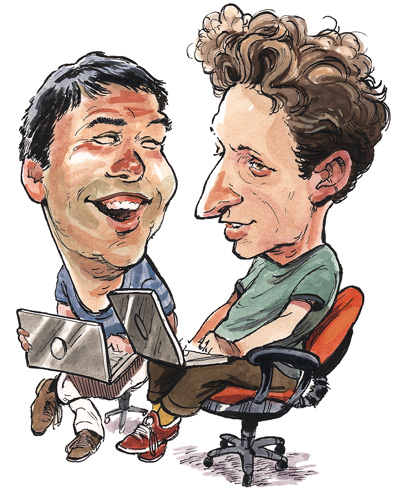
Soon after, thousands of people around the world began creating documents and programs that could be freely shared through the World Wide Web. Millions of Web sites appeared on computer screens, offering phone directories, encyclopedias, political commentary, and access to a vast global marketplace that never closes. In the 1990s, Larry Page and Sergey Brin built Google, Inc. to help the world surf the rising ocean of information. Google would locate Web sites based on their titles or their contents, while also promoting new methods of sharing information — social networking, video sharing, music downloading, and free videophone service to anywhere in the world.
12. The American Voice
While all of these ideas shape the way we live, our greatest innovation is the rich and unique American culture — the confluence of our unique system of democracy, traditions, food, thought, language, and arts, over 20 generations, that has been exported, adopted, and imitated around the world.
From baseball to rodeos, Broadway musicals to demolition derbies, the Great American Novel to comic books, blue jeans to baseball caps, surfing in Malibu to singing at the Met, cooking in the French Quarter to dancing at the Zuni pueblo, American culture continues to shape the nature and pace of change around the globe.
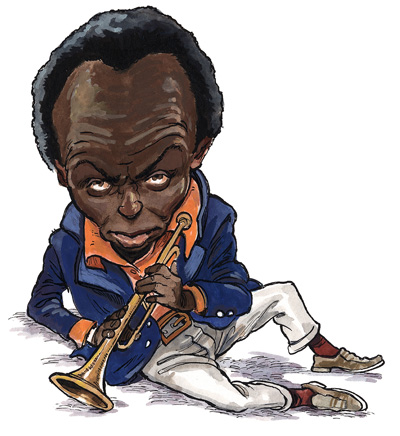
But perhaps nothing reflects the wealth of American culture like our music. It borrowed from the home cultures of its people to produce a sound unique to the world. American music’s mixed ancestry imbued it with unexpected charm and vitality. More than just a fortunate hybrid, American music was based on the blues scale — one of the most significant innovations in Western music. The blues spun off new music traditions with a strong family resemblance. We hear the distinctive blues tonal progression in gospel, bluegrass, jazz, country, rock, soul, and pop music. The distinctly authentic sound of the country created a family connection between Americans as diverse as Bessie Smith, Glenn Miller, B.B. King, Bruce Springsteen, Aaron Copland, Otis Redding, Bob Dylan, Irving Berlin, and jazz legend Miles Davis.
The genius of the American experiment is stated in our motto “e pluribus unum”—out of many, one. Our American culture enables us to share roots, while encouraging experimentation and growth—out of many comes many more.
Illustrations by Britt Spencer.